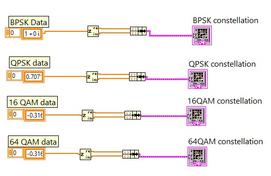Types of Modulation Techniques in Communication Systems
Advertisement
Modulation is the process of changing one or more properties of a carrier signal in accordance with the information signal (also known as the modulating signal) that we want to transmit. Think of the carrier signal as a high-frequency wave that acts as a vehicle for our information. The main goal of modulation is to “embed” the information signal onto this carrier signal so it can be sent efficiently through a communication channel.
In simpler terms, modulation is like packing your message into a special box (the carrier signal) that is suitable for traveling long distances through the air or a wire.
Types of Modulation
There are two main categories of modulation: analog and digital.
Analog Modulation
In analog modulation, the information signal is continuous, meaning it varies smoothly over time. The carrier signal (a sine wave, typically) is then modified in terms of its amplitude, frequency, or phase to reflect these smooth changes in the information signal.
Here are the common types of analog modulation:
-
Amplitude Modulation (AM): The amplitude (height) of the carrier signal is varied in direct proportion to the instantaneous amplitude of the information signal. Imagine turning the volume knob of a radio up and down based on how loud the music is.
-
Frequency Modulation (FM): The frequency of the carrier signal is changed according to the instantaneous frequency of the information signal. Think of the carrier wave’s “wiggle rate” changing with the pitch of a sound.
-
Phase Modulation (PM): The phase (position in the cycle) of the carrier signal is varied according to the instantaneous phase of the information signal. This is a bit more abstract but involves shifting the carrier wave forward or backward in time.
Applications: Analog modulation is commonly used in traditional analog radio broadcasting, analog television broadcasting, and some types of audio communication systems.
Digital Modulation
In digital modulation, the information signal is discrete, meaning it’s represented by a series of binary digits (bits) – 0s and 1s. The carrier signal is manipulated to represent these individual bits, allowing for digital data to be transmitted.
Common digital modulation techniques include:
-
Amplitude Shift Keying (ASK): The amplitude of the carrier is changed to represent binary 0s and 1s. One amplitude might represent a ‘0’, while another represents a ‘1’.
-
Frequency Shift Keying (FSK): The frequency of the carrier is shifted to represent binary 0s and 1s. Think of it as using two slightly different frequencies, one for a ‘0’ and another for a ‘1’.
-
Phase Shift Keying (PSK): The phase of the carrier is shifted to represent binary 0s and 1s. Again, we use distinct phase shifts to represent ‘0’ and ‘1’.
-
Quadrature Amplitude Modulation (QAM): Both the amplitude and phase of the carrier are varied simultaneously to represent multiple bits per symbol. This allows for more data to be transmitted at the same time.
Applications: Digital modulation is widely used in modern communication systems, including digital radio, television, cellular networks, satellite communication, and data transmission over the internet. It’s the backbone of how we communicate digitally today.
Why We Need Modulation
Modulation is essential for several key reasons:
-
Efficient Bandwidth Use: It allows us to make better use of the available bandwidth, which is a limited resource, especially in wireless communication.
-
Channel Capacity Maximization: It enables the transmission of multiple signals simultaneously over the same channel. This is crucial for maximizing the use of a channel.
-
Signal Strength and Integrity: It helps to maintain the strength and integrity of the signal over long distances. Without modulation, the signal would weaken and become distorted.
-
Frequency Shifting: It allows us to shift the information signal to a higher frequency. Antennas are much more efficient at radiating signals at higher frequencies. Think of tuning a radio – modulation allows the radio station to transmit on a specific, usable frequency.
-
Noise and Interference Resistance: Modulation schemes can be designed to be resistant to noise, interference, and distortion, enhancing the reliability of transmitted information.
-
Secure Information Transmission: Modulation can be used to encrypt the information being transmitted, providing a level of security.
-
Interoperability: By using standardized modulation techniques, various communication devices can work together seamlessly.
-
Multiplexing: Modulation is essential for multiplexing, where multiple signals are combined for simultaneous transmission.
At the receiving end, demodulation is used to separate and extract the original information signals from the modulated carrier. It’s the process of undoing the modulation.
In summary, modulation is a fundamental process in communication systems that enables efficient and effective transmission of information over various communication channels. It ensures compatibility, reliability, and optimizes the use of available resources.
Advertisement
 RF
RF






